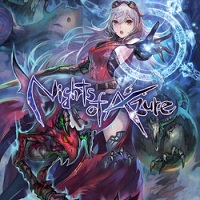From Koei Tecmo and Gust Co. Ltd., we’re brought an action RPG in the form of Nights of Azure, a game starring a half-demon known as Arnice as she battles demons to save the world from eternal night.
Nights of Azure plays like a hack and slash and looks like a visual novel. It seems like half of the game is dialogue, but we’ll get into that later. The game looks vibrant despite the usual dark atmosphere throughout most of it and is quite appealing, visually.
What isn’t entirely appealing is the repetitive nature of the gameplay—and this is coming from a big fan of the hack and slash genre. Missions will typically have you traveling from point A to point B, unlocking areas as you progress. On your way you will come across hordes of monsters that spawn out of thin air. Defeating the monsters can net you items that you can equip, and each kill rewards you with blood, which you use as experience to level up, acquire new skills, or buy equipment from demon merchants that are located within missions.
The combat can become very monotonous. Your ability to string together combos is limited, and most of the time you can get by just mashing your normal attack. In most battles, there isn’t anything forcing you to mix it up. The few different combos available do have different areas of effect. You can utilize this to your advantage depending on the spread of enemies, but really this will only get you through battles quicker. The majority of battles are so easy, you really can just keep using your normal attack to win.
Nights of Azure does break up the monotony a bit by throwing some higher level groups of monsters at you here and there, which is where one of the biggest elements of the game come into play; the Servan. Servan act as party members and autonomously attack enemies, or heal depending on what type it is. Servan have their own health and spirit meter, as do you. They can be commanded to use a burst attack which uses spirit, has an effect depending on the Servan, and generally deals a good chunk of damage (or again, heals depending on the type). You yourself also have a special attack which deals a lot of damage to a large area and can help in a pinch if you find you’re surrounded and actually low on health.

You can hold up to four Servan in your party. Each will level up as you take on missions with them and can be equipped with their own items. When in an actual difficult battle or a boss fight, micromanagement is key when commanding Servan. It’s fairly simple, hold R1 and press one of the four face buttons to call out the Servan assigned to that button. While a Servan is out, hold R1 and press their assigned button to use their burst attack.
In tougher battles, you will find yourself rapidly using the different abilities your Servan offer, managing their health and your own and efficiently taking out enemies. This is genuinely quite intuitive and if you’re good at this kind of management you will find it rewarding. However, hectic battles like these are few and far between and it’s unfortunate because these kinds of battle are kind of a thrill.

As you progress through the story, the main character acquires more abilities, such as being able to transform. You will fill up a Transformation Gauge as you fight, and upon activating it, you will transform into a demon (as well as other forms later on) and you and your Servan will be powered up. You will also gain more weapon types as well as the ability to switch and combo between them. During missions you can find fetishes that you will pick up and can be actualized into a new Servan later. Again, you can usually forget about these things as fights tend to be easy and there isn’t much need to adapt or strategize, or switch the Servan you started with except for maybe personality alone. Later in the game you can set activities for your character, which is just an option you choose before a mission and will give you additional skill points at the end of the mission.

Now, between missions and often during, you will find a lot of dialogue. Like, several minutes at a time that can go on even longer than the gameplay itself. Some of it is plot, but a whole lot of it is just banter and chit-chat. If you really enjoy easy reading, you might get something out of this, while many people will groan as they skip all of it to get the the next fight. This would be great for anyone who likes simple gameplay and visual novels if most of these scenes were actually interesting and engaging.
Nights of Azure has a lot of different things going on and a lot of neat ideas, but there could have been more focus on actual challenging fights that forced you to strategize, both on the move and ahead of time. You pick up so many items but there is rarely a time you’ll even need to consider changing your equipment because of how easy it is to get by. What we get is a lot of fluff and dry cutscenes. There was a lot of potential in this title and could have been something special had the execution been much better, but this one falls short of being awesome.



